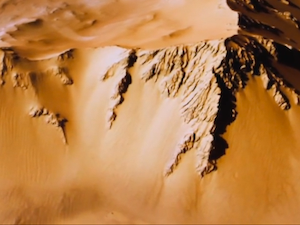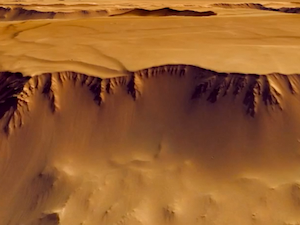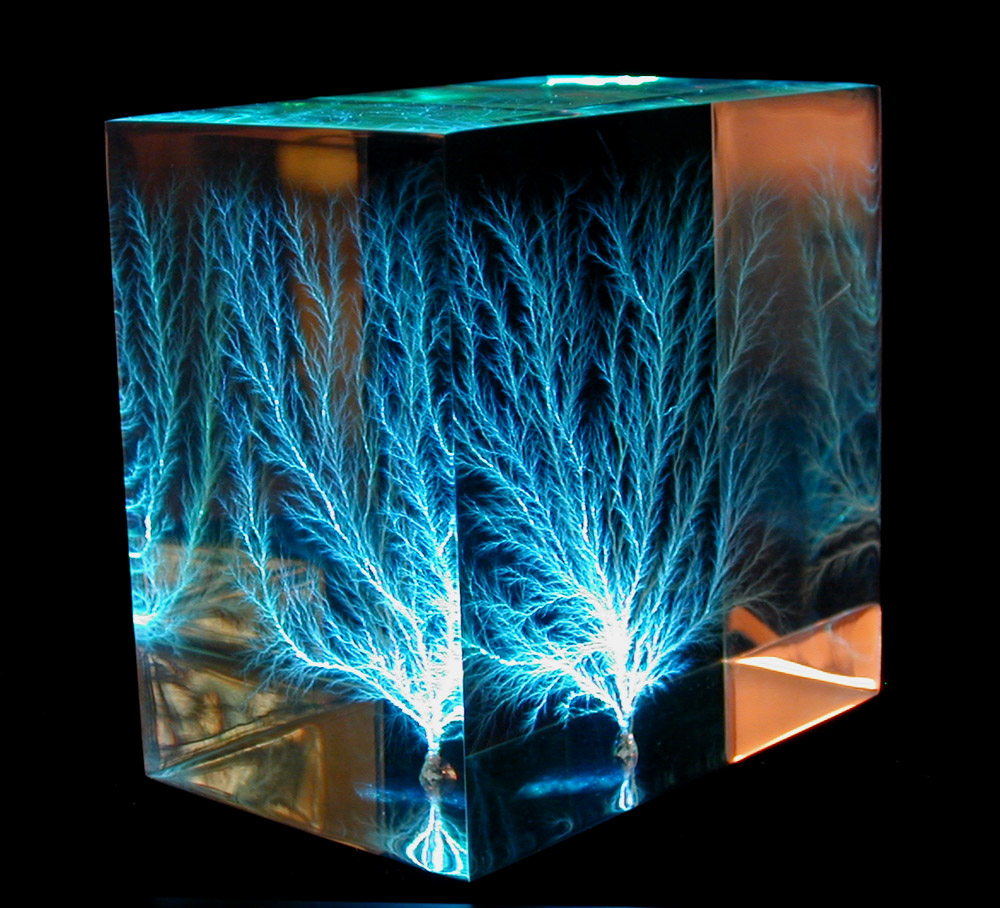Dendritic Ridges–An Electrical Interpretation
In 1777, Georg Christoph Lichtenberg demonstrated the lightning-like dendritic patterns taken by dust on non-conductive surfaces subjected to electric sparks. In honor of his contribution, these electrical patterns came to be named “Lichtenberg Figures.”

Left: Georg Christoph Lichtenberg. Center: Electric arc in Lichtenberg pattern; Right: Martian ridge system. Images from the video clip Mars’ Greatest Mystery.
Lichtenberg experimented with variations in the observable effects of electric sparks to surfaces of different characteristics, including positively and negatively charged materials. Thanks to him and his successors, it is now known that dusty surfaces can display the effects of gaseous electrical discharge streamers or leaders along insulating materials, also called dielectrics. In the literature, these are sometimes called “sliding discharges” or “gliding discharges.”

Ridges down steep cliffs of giant Martian mesa. Credit: NASA/Google Mars
Through a series of complex interactions between the ionized gas channels and the surface of the dielectric below, electrical charge is transferred to or from the dielectric surface immediately below the discharge. This leaves behind invisible charged regions on the surface of the dielectric that trace the paths taken by the previous discharge.
These localized charges become temporarily stranded in good dielectrics since dielectrics prevent charges from easily moving and dissipating. These stranded-charge regions become visible when oppositely-charged dust is sprinkled onto the surface, standing out as raised Lichtenberg patterns (as distinct from the familiar dendritic channels or ravines often cut by electric sparks.)
However, raised Lichtenberg “dust figures” only form on the surfaces of materials that are excellent dielectrics. Some of these include common plastics, resin, wax, amber, sulfur, sapphire, and some glass formulations. These materials have resistance levels in the range of 113 to 124 ohm-cm. Leakier materials allow deposited charge to dissipate more quickly.
The rate that charge leaks away is exponential with a time constant that is proportional to the ratio of the dielectric constant of the material : (k) times its resistivity (r) – similar to the voltage decrease of a discharging capacitor in an RC circuit. While stranded surface charges on clean Teflon (r = 122 – 124 ohm-cm) may remain for many decades, they will remain only for a few days on Carnauba wax (r = 118 ohm-cm) , and only minutes or hours for most common plastics. Once the bulk resistivity of a material goes below ~113 ohm-cm, deposited surface charges leak away in a matter of a second or less.

Dendritic ridges in “fractured terrain” of Noctis Labyrinthus. Credit: NASA/Google Mars
Common rocks and soil on Earth are much more electrically conductive than the materials mentioned above due, in part, to the inclusion of water and mobile ions. Ground conduction and system “grounding” for electrical power systems, antennas, and lightning rods rely on the slight electrical conductivity of soil, rock, and moisture.
For example, dry sandy soil has a resistivity of ~15 ohm-cm. Any deposited surface charge (for electrostatic Lichtenberg Figure formation) would leak away within microseconds. And, most other soils and rocks are even more conductive.
The situation for larger electrostatic Lichtenberg-like structures might be somewhat different on an extremely dry planet or moon. The pressure of the atmosphere is also important since electrical breakdown limits how much of a charge differential can exist between regions. The “form” of the Lichtenberg Figure is also a function of gas constituents and pressure. Generally, Lichtenberg discharge paths become wider as pressure is reduced until the Paschen minimum is reached.

Experimentalists discovered that patterns of electric discharge could be preserved inside low-conductivity materials like the Lichtenberg formation, or “frozen lightning,” in clear acrylic at Stoneridge Engineering.












